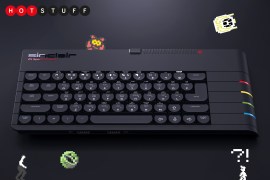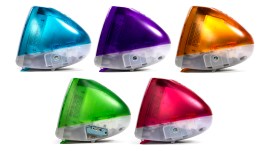I hope another Sinclair can ignite a gaming revolution with the Pi-powered GamerCard
Featherweight handheld coming from Sir Clive Sinclair’s nephew

The name Sinclair runs through the DNA of British tech like a stick of seaside rock. In the 1980s, Sir Clive unleashed a gaming revolution with the ZX Spectrum, a machine on which many of today’s gaming luminaries cut their teeth. Now, Sir Clive’s nephew is attempting to spark his own gaming revolution with GamerCard.
Like the ZX Spectrum, Grant Sinclair’s creation is built for tinkerers who crave something a bit different from the norm. Its guts are typical enough. The brains are a Raspberry Pi Zero 2W with 128GB storage. There’s a 1600 mAh battery that’ll keep the unit going for hours on a single charge. And you get HDMI and USB-C connectors. However, Qwiic connectivity aligns GamerCard with the geek sensibilities of the Sinclair name. And the lush 4in 254ppi 1:1 IPS display stands out from the competition and should make your eyes happy while gawping at games.
Speaking of, GamerCard doesn’t ship with a library of dubiously sourced titles. But it does preload two game that began life on the Switch (platformer Bloo Kid 2 and shooter AstroBlaze DX). A launcher then provides fast access to additional games through emulation or Pico-8 – the faux-9-bit console that’ll set you back $15 and unlock hundreds of tiny indie gems.
Design of the times
Just like the ZX Spectrum stood out among the boxy, beige monstrosities of its day, GamerCard is a svelte number in a sea of chunky handhelds. It’s a ridiculous 6.5mm thin – about a third of the depth of most portables in this space – and weighs just 100g. This is achieved thanks to a “next-gen PCB sandwich construction that replaces traditional body cases and eliminates wasteful manufacturing processes”.
The controls are even weirder. No Speccy rubber keys here, but you do get two control pad discs for navigation and play. It’s impossible to say how they’ll fare when confronted with a game designed for a traditional D-pad. Sinclair told Stuff the discs “have snap domes underneath that are super-tactile and were tested by gamers over several months”. He added this was one of the “hardest details to get right” but said it is “now perfect”.
Perfect is a high bar, but I’m intrigued. I’m a fan of 1:1 handhelds – they’re ideal for Pico-8, vertical arcade games and a bunch of other classic systems. And GamerCard should cope with anything up to the (original) PlayStation. But I’m a mite concerned how a super-skinny unit with oddball controls will feel to play.
There’s also the small matter of the price. The GamerCard will set you back £125 (about $170), which isn’t cheap, especially when you stack it up against something like the TrumUI Brick – a chunkier beast at 20mm, but more powerful and half the price. Still, if you’re into stylish oddballs or want to help the Sinclair name on its next adventure, grab a GamerCard right now from grantsinclair.com.



